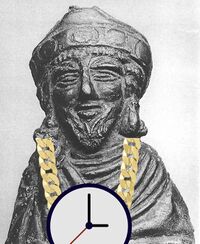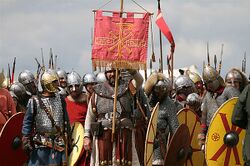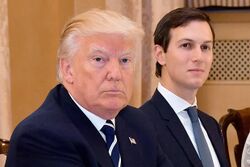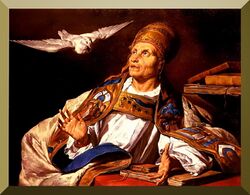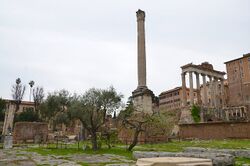Phocas
Phocas (Latin: Flava Flavius Focas; c. 547 – 5 October 610) was the Byzantine emperor from 602 to 610, a period of history in which mankind discovered that decapitation was a highly efficient alternative to crucifixion and comparable methods that had come before.
The reign of Phocas, which started in the same way as it ended,[1] faced the same problems as modern government does, from opposition by the "Deep State," to problems with the in-laws, to spending excessive time striving against real and imagined enemies.
Early life[edit]
Coming out of nowhere, little about Phocas's early life is known, such as where and when he was born. Unlike conventional emperors, he did not attend Emperor School nor serve as the emperor's apprentice. Historians have not even been able to learn more about Phocas from his barber, as Phocas famously did not use one. He did join the army and was a low-ranking officer with a beard under Emperor Maurice.
Coronation[edit]
By 602, Phocas was a centurion with a beard under Maurice. The army were north of the Danube and their fingers and toes were turning Blue. Their pay had been cut and the food was pretty awful as well. To the good, having an ice-caked, mangy beard did not seem as flagrant a violation of the army's grooming standards as it once had, before it became ice-caked. In fact, Phocas was fitting in so well that the army rebelled and declared him the emperor, on the grounds that he could not possibly be as bad as Maurice — a decision that suggests that they might better have concentrated on warfare.
Phocas was crowned by the patriarch at St John the Baptist at the Charlie Hebdomon. Word reached Maurice, who concluded that discretion might be the better part of valor. He got out of town, with two of his sons, and Phocas entered Constantinople without opposition. However, Maurice could have used a bit more discretion (complete exile seeming more appropriate in retrospect), as the entire family was captured and executed.
Reception[edit]
It may surprise the reader that Constantinople had people in it other than the Emperor — scads of institutions, minor officials, cliques, and gossips, in fact — and they all wanted to know where did this bearded pipsqueak come from? This query, repeated locally throughout the empire, Phocas never answered. Instead, he spent most of his time and energy tracking down and purging enemies, and when they kept conspiring against him, murdering them.
Consequently, there were few candidates for senior military positions. He turned to family members, and there weren't many of these:
- Domentziolus (his brother) as Minister of Defence
- The other Domentziolus (his nephew) as Commander of the Eastern Provinces
- His other brother, Comentiolus, in the same post in 610
- Half-brother Rocki-olus, as Procurator of Jukeboxes
For Captain of the Excubitors, he had run out of blood relatives, and tapped Priscus, who had married Phocas's daughter.[2] The reader will see that relying on the in-laws was a fateful mistake.
Foreign relations[edit]
Byzantium had been at peace with Persia, as Emperor Maurice had installed, bought off, and almost converted King Khosrow II. However, the coup that installed Phocas was a "deal-breaker," and the Persians invaded in 603. They quickly bit off Phocas's eastern provinces, leading Commander Narses to defect to their side. Phocas dealt with this by inviting Narses to Constantinople for a parley, in which Narses had surprisingly little to say, as they burned him alive. This opened up a cushy executive position for Domentziolus to occupy — while simultaneously discouraging competition for the job — but it didn't stop the Persians. By 607, they owned Mesopotamia, Syria, and a major portion of Asia Minor.
Meanwhile, the Avars retook the northern Balkans, slaughtering or enslaving the Christian population. They were mean sons-of-bitches. Also, Italy was back under attack from the Lombards (pictured, left), and defending it was way down Phocas's to-do list.
Gregory the Great, bishop of Rome, praised Phocas as a restorer of liberty, perhaps being poorly informed of his other role as a remover of heads. Phocas sent an autographed portrait of himself and The Missus to Rome to be placed in the oratory of St Caesarius. Consequently, there was no need for Phocas to open up a fourth battle front, against the Catholic Church. Phocas gave the official approval for Boniface III to become the Pope, though he dragged his feet on the proclamation for a year, as he had a lot of people he had to kill first.
Downfall[edit]
Emperor Maurice had combined military and civilian offices in the provinces in several Exarchs, offices he intended his sons to occupy. Theirs were the first heads that rolled, though, so Heraclius was still the Exarch of Cartilege. That shifty in-law, Priscus, got fed up with Phocas and asked Heraclius to knock him off. Heraclius invaded by land and sea in 609. On 5 October 610, Heraclius seized Constantinople, declared himself emperor, and finished Phocas's time on the throne with the same gore with which it had begun.
Moreover, Heraclius got to write the history of Phocas's rule, which is perhaps why posterity views Phocas as a villain. In fairness, Phocas's term of office did feature massive public works — to-wit, one massive statue of himself, called the Column of Phocas, in the Roman Forum. It was erected by Smaragdus (friends called him "Smarmy"), whom Phocas recalled to Rome after a long exile and made the Exarch of Ravenna (Governor of Rome). The Column has a unique free-standing position in the Forum, not unlike Rome's own position under the advancing Lombards. The spire uses a style that had become passé in the 2nd century, and may have been dug out of the maintenance shed, but on top was a "dazzling" gilded statue of Phocas, complete with glued-on costume beard. The statue went up in 608. It came down in 610, a short time after Phocas himself did.
References[edit]
- ↑ Bloodily.
- ↑ She has a name, you know. You know what she's called? She's called "Domentzia." Domentzia Buttocks.
See also[edit]
| Preceded by: Maurice |
Byzantine Emperor 602–610 |
Succeeded by: Heraclius |
